You could start a laurel hedge or row of emerald cedars, and effectively create a living fence of your own. However, a more pleasant solution in the long run may be to create a backdrop of flowering shrubs, which may not entirely block the neighbour's fence, but will soften and brighten your property boundary, and provide year-round drama and colour. Plant smaller shrubs and perennials in front, and you have a rich, multi-textured, colourful garden border.
If space is an issue, another alternative is to set up a lattice, and introduce some colourful and quick-growing vines. There are many options, and this can be explored in another article.
In this article, we will explore some relatively fast-growing shrubs suitable to the Pacific Northwest climate, which will quickly and effectively fill an area with texture, seasonal colour and even fragrance. I would welcome you to suggest your own favourites, too.
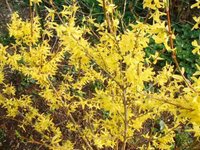
Forsythia - The cheery yellow-flowering twigs of the forsythia are one of the early signs of Spring (February), followed by pleasant chartreuse leaves which darken in the Fall. The growth habit is untidy, but there is a raw natural beauty to the arching branches, and if desired, it can be trimmed to a hedge shape.
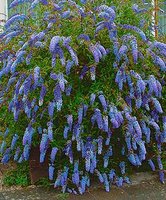 Buddleia davidii (Butterfly bush) - This non-native but incredibly hardy bush grows to an amazing size of 6' or more in its first year, with long flowerets which are irresistible to butterflies. The common one (which often grows wild along railway tracks, and can be seen in the hillsides along the highway heading to Horseshoe Bay) has purple flowers, but it can be found in all shades of white through purple, pinks through reds, and even orange. Photo on right of "Nanho Blue".
Buddleia davidii (Butterfly bush) - This non-native but incredibly hardy bush grows to an amazing size of 6' or more in its first year, with long flowerets which are irresistible to butterflies. The common one (which often grows wild along railway tracks, and can be seen in the hillsides along the highway heading to Horseshoe Bay) has purple flowers, but it can be found in all shades of white through purple, pinks through reds, and even orange. Photo on right of "Nanho Blue".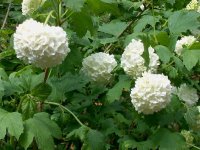 Viburnum opulus "Roseum" (European snowball) - What a delight to have snowballs in the middle of summer! This is a pretty bush when in bloom, and the snowballs make a nice cut flower, too.
Viburnum opulus "Roseum" (European snowball) - What a delight to have snowballs in the middle of summer! This is a pretty bush when in bloom, and the snowballs make a nice cut flower, too.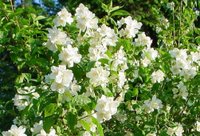
Philadelphus lewisii (Wild mock orange) - This fast-growing bush is Idaho's state flower, and bears lovely white and very fragrant blossoms.
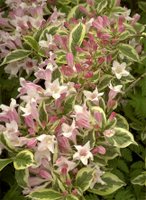 Weigela - These are beautiful, fast growing and hardy bushes, available in a variety of flower colours (white through red). When in bloom, they are completely covered in bell-like flowers, and attract hummingbirds. The branches can be left in their natural drooping shape, or trimmed to a hedge or standard. My favourite is the Weigela florida "Variegata", with its variegated leaves and pink flowers.
Weigela - These are beautiful, fast growing and hardy bushes, available in a variety of flower colours (white through red). When in bloom, they are completely covered in bell-like flowers, and attract hummingbirds. The branches can be left in their natural drooping shape, or trimmed to a hedge or standard. My favourite is the Weigela florida "Variegata", with its variegated leaves and pink flowers.
Syringa vulgaris (Lilac) - What yard could be complete without a lilac bush? There are so many options, from single flowered to double flowered, white through deep purple, pinks. The "Sensation" variety has single purple flowers outlined in white - truly sensational. Watch for fragrance, too, if you are intending to bring the flowers indoors - some varieties are more fragrant than others.
Sambucus racemosa (Red elderberry) - If you walk on the wild side, this native shrub is a nice addition, and very fast-growing. The creamy white flowers are not showy, but the red berries (which slightly poisonous to humans unless cooked) are attractive, and provide food for birds.
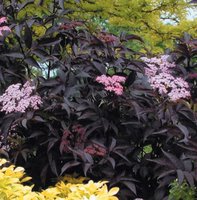 Sambucus nigra (Black elderberry) - Similar to the red elderberry, but its creamy white flowers make way to purplish black b
Sambucus nigra (Black elderberry) - Similar to the red elderberry, but its creamy white flowers make way to purplish black b erries, also inedible unless cooked (so some potential for jams or wines, although I would question what quantities would be needed). There are two outstanding cultivars, the "Black Beauty" (photo on left) with its dark, almost black leaves, and pink flowers, and the "Black Lace" (photo on right) with its finely divided black leaves (resembling a Japanese split maple) and deep pink flowers.
erries, also inedible unless cooked (so some potential for jams or wines, although I would question what quantities would be needed). There are two outstanding cultivars, the "Black Beauty" (photo on left) with its dark, almost black leaves, and pink flowers, and the "Black Lace" (photo on right) with its finely divided black leaves (resembling a Japanese split maple) and deep pink flowers.
Callicarpa bodinieri (Bodinier beautyberry) - This native of China produces outstanding clusters of vivid purple berries along the stems, which look amazing when the leaves drop in Fall, leaving behind a eye-catching purple bush! The berry-laden stems are great for cut "flower" arrangements.
Corylus avellana (Common hazel) - Although not flowering as such, this nut-producing shrub will certainly bring wildlife into the yard - very popular with squirrels and Stellar's jays! The "Contorta" (Corkscrew hazel or Contorted filbert) cultivar is popular, with its bizarre curly branches.
Other shrubs which should be considered, although not as fast-growing, but are great for middle or back of the garden border, include hydrangeas, rhododendrums, various spireas, and various viburnums.


No comments:
Post a Comment